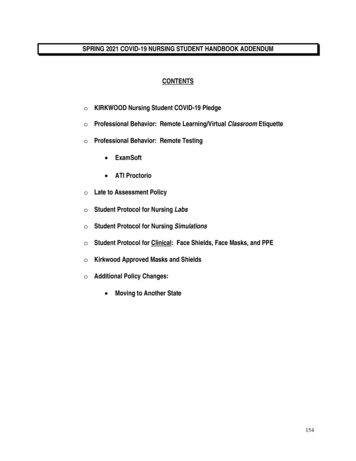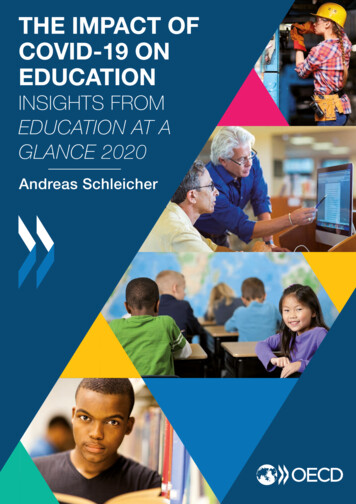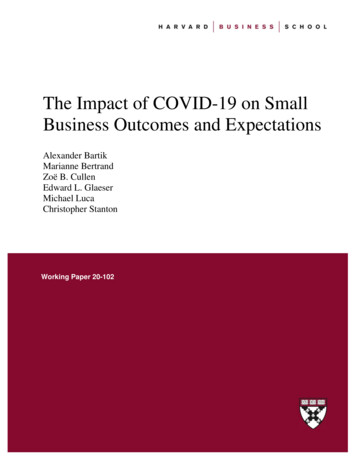
Transcription
Educational Resurgence Journal Volum2,Issue 5,Jan.2021ISSN 2581-9100An analysis of COVID-19 ImpactsOnIndian Education SystemMukesh RawalBE (Mech), PGP-PM- NICMARMember: IEIL, ASME, IWS, ILCE, CEAIABSTRACTIndian education system is still not mature at both the urban and rural area. Midday meal is the program organized to attract the students to get education. Under thesecircumstances government imposed nation wise lockdown on March 25th, 2020 to combatCOVID-19, has made severe impact on the education system. India has the world’s secondlargest school system, after China. According to UNESCO, 63 million teachers were affectedin 165 countries. A total of 1.3 billion learners around the world were not able to attendschools or universities, and approximately 320 million learners are affected in India alone.It has changed the traditional education system to the educational technologies model inwhich teaching and assessments are conducted online. Both the positive and negativeimpacts of COVID-19 on Indian Education system are observed.This paper aims to analyze the Impact of COVID-19 on Indian Education System,focusing on education during online teaching and assessment of students getting onlineclasses in this pandemic from settings at home.INTRODUCTIONIndian government has announced the lockdown and closure of educationalinstitutions as a logical solution to enforce social distancing within communities. Thenationwide lockdown has had a tremendous impact on the education system of thecountry, especially for students from rural areas. Since the Indian education system isdominated by classroom study, the present scenario has made the functioning of theeducational institutions go very difficult.All educational activities like examinations, school admissions, entrance tests ofvarious universities and competitive examinations, others, are being held during thisperiod. As the days are passing by with no immediate solution to stop this outbreak, theclosure of schools and universities is hugely affecting the learning across the country. Thestructure of the Indian education system i.e. learning methodology, teaching techniques &assessment methodologies, is quite affected, resulting in a shift to online education with35
Educational Resurgence Journal Volum2,Issue 5,Jan.2021ISSN 2581-9100most focus on virtual education to accomplish the set aims and objectives. But only ahandful of schools and universities could adopt such methods and the low-income privateand government schools are quite inefficient to adopt the same, thus resulting in ashutdown.OBJECTIVESThe overall objective of this study is to analyze the Impact of COVID-19 on IndianEducation System. In particular, this study will examine:i.ii.iii.How the Indian education system is facing the Impact of COVID-19, andhighlighting the role played by teachers and students through online educationHow the positive impact helpful to student, parents and school teachers in thescenario of the online educationHow to reduce the negative impact of COVID-19 on students for their smootheducation.METHODOLOGYData and information presented in the study are collected from various reports andarticles published by national and international agencies on impact of COVID-19 pandemic.Information is also collected from various authentic websites. Some journals are alsoreferred relating to impact of COVID-19 on educational system are referred.PURPOSE OF THE STUDYAll systems have strengths and weaknesses. Maximizing strengths and minimizingweaknesses in order not to miss the opportunity to move forward should be the goal. Themain purpose of the study is to analyze the impact of COVID-19 on the Indian educationsystem. It covers the impact of COVID-19 on rural and urban students, Higher educationInstitutions.DIGITAL INFRACTURE IN INDIABefore the COVID-19 lockdown in India, no one estimated that the face of the Indianeducational institutions could change so drastically. Schools that never allowed students tocarry an electronic gadget turned into learning centers for online classes. Both teachers andstudents are getting familiar to this new normal, which is definitely more challenging forthe teachers to handle with this situation. The teachers also face challenges in designingeffective lessons and changing of teaching when shifting to online learning; this can also beresolved through workshops and training.36
Educational Resurgence Journal Volum2,Issue 5,Jan.2021ISSN 2581-9100According to the key indicators of Household Social Consumption on Education in Indiareport, based on the 2017-18 NSSO, fewer than 15% of rural Indian households haveinternet access (as opposed to 42% urban Indian eAccessComputer (%) Internet (%) Computer (%) Internet (%)1Andhra .555.58Himachal Pradesh10.548.628.370.69Jammu & adhya 21Uttar Pradesh4.011.622.341.022West Bengal3.37.923.036.0Source: 75th round of National Sample survey conducted between July 2017 and June 2018Availability of electricity is a significant challenge to taking advantage of educationonline. In a recent 2017-18 survey, the Ministry of Rural Development found that only 47%of Indian households receive more than 12 hours of electricity and more than 36% ofschools in India operate without electricity. This suggests that while students from familieswith better means of living can easily bridge the transition to remote learning, studentsfrom underprivileged backgrounds are likely to accede to inefficiency and a lack ofadaptation, either because of the inaccessibility of the technology or the low education oftheir parents to guide them through tech-savvy applications. Non-availability of technicalinfrastructure and irregular interrupted internet connectivity all across India is the biggestchallenge in front of the students and teachers.37
Educational Resurgence Journal Volum2,Issue 5,Jan.2021ISSN 2581-9100IMPACT ON TEACHERS AND STUDENTSBoth teachers and students are facing many hurdles during online education. Athome, a lack of basic facilities, external distraction and family interruption during teachingwere major issues noticed. Educational institution support barriers such as the budget forpurchasing advanced technologies, a lack of training, a lack of technical support and a lackof clarity and direction were also noticed. Teachers also faced technical difficulties. Thedifficulties were grouped under a lack of technical support; it included a lack of technicalinfrastructure, limited awareness of online teaching platforms and security concerns.Teachers’ personal problems including a lack of technical knowledge, course integrationwith technology are damper their engagement in online teaching.Positive impact on education system:Though the outbreak of COVID-19 has created many negative impacts on education,educational institutions of India have accepted the challenges and trying their best toprovide seamless support services to the students during the pandemic. Indian educationsystem got the opportunity for transformation from traditional system to a new era. Thefollowing points may be considered as the positive impacts. Develop the use of soft copy of learning material- In lockdown situation,students were not able to collect the hard copies of study materials and hence mostof the students used soft copy materials for reference. Improvement in collaborative work- There is a new opportunity wherecollaborative teaching and learning can take on new forms. Rise in online meetings- The pandemic has created a massive rise inteleconferencing, virtual meetings, webinars and e-conferencing opportunities. Enhanced digital literacy- The pandemic situation induced people to learn and usedigital technology and resulted in increasing the digital literacy. Improved the use of electronic media for sharing information- Learningmaterials are shared among the students easily and the related queries are resolvedthrough e-mail, SMS, phone calls and using different social medias like WhatsApp orFacebook. Worldwide exposure- Educators and learners are getting opportunities to interactwith peers from around the world. Learners adapted to an international community. Better time management- Students are able to manage their time more efficientlyin online education during pandemics. Demand for Open and Distance Learning- During the pandemic situation, most ofthe students preferred Open and Distance Learning mode as it encourages selflearning providing opportunities to learn from diverse resources and customizedlearning as per their needs.38
Educational Resurgence Journal Volum2,Issue 5,Jan.2021ISSN 2581-9100Negative impact on education system:Indian education system has suffered a lot due to the outbreak of COVID-19. It has createdmany negative impacts on education and some of them are as pointed below: Educational activity hampered- Schools are closed and classes have beensuspended. Different boards have already postponed the annual examinations andentrance tests across India. Unpreparedness of teachers and students - Teachers and students areunprepared for online education; they were not ready for this sudden transitionfrom face to face learning to online learning. Parents’ role- In urban area some educated parents are able to guide but some maynot have the adequate level of education needed to teach children in the house. Digital gadgets: Especially in rural area many students have limited or no internetaccess and many students may not be able to afford computer, laptop or supportingmobile phones in their homes, online teaching-learning may create a digital divideamong students. The lockdown has hit the poor students very hard in India as mostof them are unable to explore online learning according to various reports. Create Difference: This online teaching-learning method creates a big gap betweenrich vs poor and urban vs rural students.OBSERVATION AND RECOMMENDATIONThis pandemic has revealed some of the major loopholes in the Indian educationsystem. The closure of schools has made a severe impact on marginalized students.One of the critical trends that can be followed is the need to have a combined approach toonline learning with increase in investment on the upgrading of the technologyinfrastructure of educational institutions. Stress needs to be given to training the teachers.All higher education institutes now are aware of the importance of technology and shouldtake serious measures to conduct technology-driven education through the learningmanagement system. It is recommended that educational institutions should usetechnology in all aspects. This pandemic shows the partnership between technology andeducation is going to stay forever.One more suggestion is that education Institutes can divide the courses intoconventional teaching and online teaching, it will help in inculcating the technology into theclassrooms. Online teaching will increase digital literacy among teachers and studentswhich will increase their exposure and learning and making them more employable for thedigital world-leading thereby contributing to social sustainability.39
Educational Resurgence Journal Volum2,Issue 5,Jan.2021ISSN 2581-9100CONCLUSION:COVID-19 has impacted immensely the education sector of India. Though it hascreated many challenges, various opportunities are also evolved. The Indian Govt. anddifferent stakeholders of education have explored the possibility of Open and Distancelearning by adopting different digital technologies to cope up with the present crisis ofCOVID-19. India is not fully equipped to make education reach all corners of the nation viadigital platforms. The students who aren’t privileged like the others will suffer due to thepresent choice of digital platforms. The priority should be to utilize digital technology tocreate an advantageous position for millions of young students in India. It is need of thehour for the educational institutions to strengthen their knowledge and InformationTechnology infrastructure to be ready for facing COVID-19 like situations.Even if the COVID-19 crisis stretches longer, there is an urgent need to take effortson maximum utilization of online platforms. India should develop creative strategies toensure that all children must have sustainable access to learning during pandemic COVID19. As online practice is benefitting the students immensely, it should be continued afterthe lockdown. Further detailed statistical study may be undertaken to explore the impact ofCOVID-19 on education system of India.References:1. https://en.unesco.org/covid19/educationresponse2. https://www-indiatodayin.cdn.ampproject.org/v tional-education3. http://www.educationinsider.net/detail news.php?id 13264. chools/Digital-Strategy- for-Schools/ al-Strategy-for-Schools- ConsultativePaper.pdf40
through e-mail, SMS, phone calls and using different social medias like WhatsApp or Facebook. Worldwide exposure- Educators and learners are getting opportunities to interact with peers from around the world. Learners adapted to an international community. Better time management











